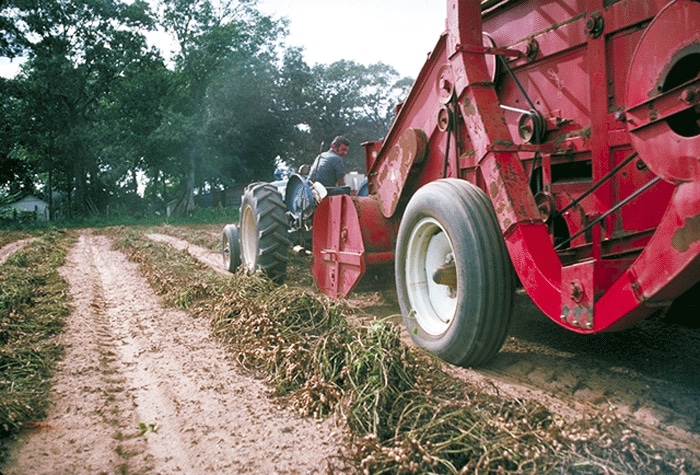
National Posted Price for Peanuts at all-time high
• The National Posted Price for Peanuts is not an actual price, but it’s likely based on current market conditions and indicators such as shelled prices, international bids and the weekly price report published by NASS.• The actual formula is a ‘black box,’ meaning the formula is not made available to the public.• The rise of the NPP has been meteoric, beginning during October of 2010 from $450 per ton.• But just because the NPP is now $950 per ton, it doesn’t mean a grower can get a contract for that amount.
July 20, 2011

How high can it go? Farmers who have been asking this question about cotton prices in recent months are now asking the same thing about the USDA Weekly National Posted Price (NPP) for Peanuts, which was sitting at a remarkable $949.54 per ton for runners during the last week of June.
It’s an all-time high for the NPP, but does it mean anything?
Unlike other commodities, there’s not a futures market for peanuts because there’s not a large enough volume of trade, so pricing can be an inexact science.
The Farm Service Agency determines the NPP which the Commodity Credit Corporation (CCC) uses to set the repayment rate for loan peanuts, explains Nathan Smith, University of Georgia Extension economist. When the NPP falls below the national loan rate of $355 per ton, the NPP becomes the repayment rate.
“It’s not an actual price, but it’s likely based on current market conditions and indicators such as shelled prices, international bids and the weekly price report published by NASS. The actual formula is a ‘black box,’ meaning the formula is not made available to the public.
The rise of the NPP has been meteoric, beginning during October of 2010 from $450 per ton.
But just because the NPP is now $950 per ton, it doesn’t mean a grower can get a contract for that amount, says Smith.
“If the right events occur, we could actually get to that point,” he says. “But that price isn’t reflective of what growers can get right now. Considering the kind of start we’ve had to the season and the decrease in planted acres, we could get to that point.”
Reports from the field are that contracts for new 2011 crop peanuts remain at $600 per ton for Southeast runners. The $950 NPP and the $600 contract prices might be bookends for what market prices might be in the future, says Smith. One company has offered 80 cents per pound for shelled peanuts, and that also might be influencing the NPP.
Both buyers and sellers are remaining quiet until more is known about this year’s crop.
Shellers reportedly have offered farmers $750 per ton for peanuts remaining in the loan, plus they agree to pay the storage and handling. The Marketing Loan Assistance tonnage must be redeemed within nine months of placing the peanuts in the loan.
Waiting for more information
Many farmers are opting to wait for more market information before pulling the trigger on contracts, though some who needed the money for planting the new crop did opt for contract offers.
With the strong markets and shrinking supply, all 2010 peanuts in the Market Loan Assistance Program (MLA) are expected to be purchased at some price. Most of the peanuts in the MLA program were Option Contract-priced earlier in the season.
“I think prices to growers will work themselves toward the NPP, but several factors will be influencing the market,” says Smith.
During the last week in June, Georgia’s peanut crop looked better than the cotton crop, he says, but many stands are skippy, even under irrigation. “We’re talking more now about being able to make an average crop. At this point, we’re not expecting a record crop,” he says.
According to USDA’s acreage estimate released on June 30, the U.S. area planted to peanuts in 2011 is at 1.15 million acres, down 11 percent from 2010. Area for harvest is forecasted at 1.12 million acres, also down 11 percent from last year.
Severe drought conditions in the South and higher cotton prices were the primary factors leading to the decrease in peanut acres. In Georgia, the largest peanut-producing state, area planted to peanuts is the lowest since 1982 and planted acres in Texas are the lowest since 1926.
Planted area continues to decrease in the Virginia-North Carolina region as growers have switched to more profitable crops such as corn, soybeans and cotton.
By June 19, 96 percent of the peanut crop had been planted, 2 percentage points behind last year. As of June 26, the crop was rated 29 percent good to excellent, compared with 71 percent last year.
The CCC has announced the 2011 loan rates for the four types of peanuts. CCC calculated the price support levels for each type using the same method as last year. It uses the national average loan rate of $355 per ton and the five-year average quality factors along with a three-year simple average weighted production.
Rates are effective Aug. 1, 2011. Based on the type, quality and locations, the average ton loan levels are $354.32 per ton for runner-types, $345.87 per ton for Spanish-types; $358.26 per ton for Valencia-types; and $358.26 for Virginia-types.
CCC applies premiums and discounts for quality factors to compute the loan value for an individual ton of peanuts. The actual loan level depends on the percent of various sizes of kernels in each ton.
CCC uses the percentage of Sound Mature Kernels (SMKs) and sound splits (SS) to compute the basic loan value. SMKs are whole kernels that pass over the testing screen of each type. Sound splits are whole kernels split into two pieces.
Excess sound splits receive a “discount.” There are also discounts for “other kernels” (OK), damaged kernels (DK) and foreign materials (FM). An additional discount occurs for loose shell kernels (LSKs).
About the Author(s)
You May Also Like



